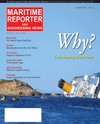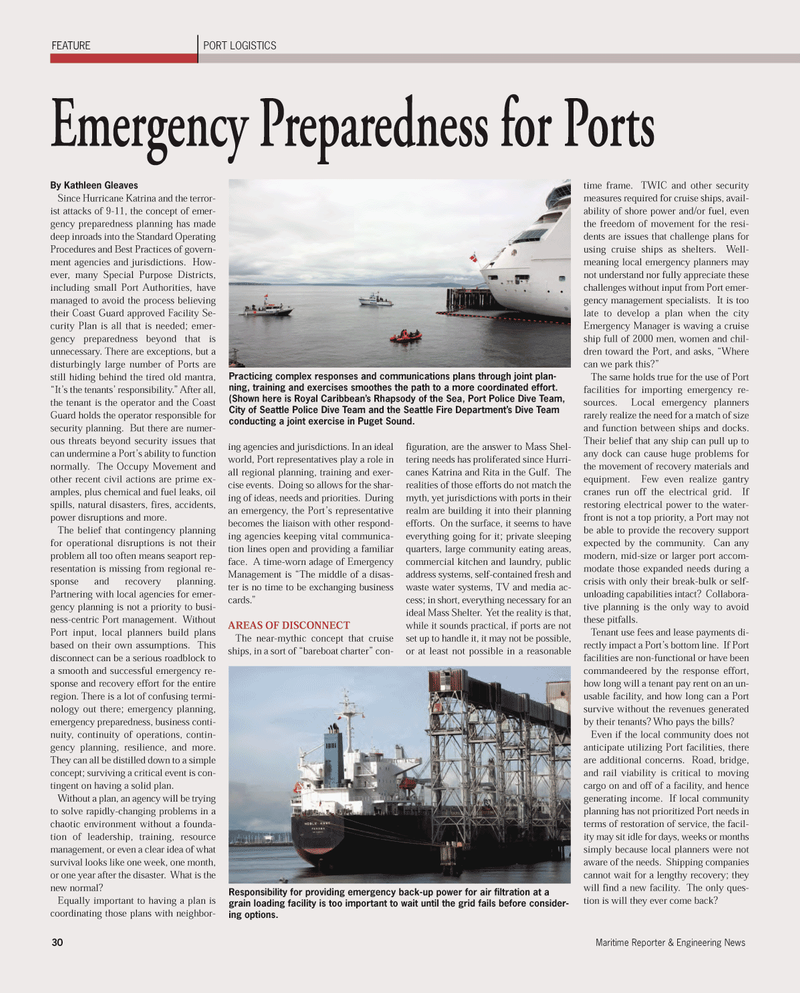
Page 30: of Maritime Reporter Magazine (February 2012)
Cruise Shipping Annual
Read this page in Pdf, Flash or Html5 edition of February 2012 Maritime Reporter Magazine
30Maritime Reporter & Engineering News PORT LOGISTICSFEATURE By Kathleen GleavesSince Hurricane Katrina and the terror- ist attacks of 9-11, the concept of emer- gency preparedness planning has made deep inroads into the Standard OperatingProcedures and Best Practices of govern- ment agencies and jurisdictions. How- ever, many Special Purpose Districts, including small Port Authorities, have managed to avoid the process believing their Coast Guard approved Facility Se- curity Plan is all that is needed; emer- gency preparedness beyond that is unnecessary. There are exceptions, but a disturbingly large number of Ports are still hiding behind the tired old mantra,?It?s the tenants? responsibility.? After all, the tenant is the operator and the CoastGuard holds the operator responsible forsecurity planning. But there are numer- ous threats beyond security issues that can undermine a Port?s ability to function normally. The Occupy Movement and other recent civil actions are prime ex- amples, plus chemical and fuel leaks, oilspills, natural disasters, fires, accidents, power disruptions and more. The belief that contingency planning for operational disruptions is not theirproblem all too often means seaport rep-resentation is missing from regional re- sponse and recovery planning. Partnering with local agencies for emer- gency planning is not a priority to busi- ness-centric Port management. Without Port input, local planners build plans based on their own assumptions. This disconnect can be a serious roadblock toa smooth and successful emergency re- sponse and recovery effort for the entire region. There is a lot of confusing termi- nology out there; emergency planning, emergency preparedness, business conti- nuity, continuity of operations, contin- gency planning, resilience, and more. They can all be distilled down to a simple concept; surviving a critical event is con- tingent on having a solid plan. Without a plan, an agency will be trying to solve rapidly-changing problems in a chaotic environment without a founda- tion of leadership, training, resourcemanagement, or even a clear idea of what survival looks like one week, one month, or one year after the disaster. What is the new normal? Equally important to having a plan is coordinating those plans with neighbor- ing agencies and jurisdictions. In an idealworld, Port representatives play a role in all regional planning, training and exer- cise events. Doing so allows for the shar- ing of ideas, needs and priorities. Duringan emergency, the Port?s representative becomes the liaison with other respond-ing agencies keeping vital communica- tion lines open and providing a familiar face. A time-worn adage of Emergency Management is ?The middle of a disas-ter is no time to be exchanging business cards.? AREAS OF DISCONNECTThe near-mythic concept that cruise ships, in a sort of ?bareboat charter? con-figuration, are the answer to Mass Shel-tering needs has proliferated since Hurri- canes Katrina and Rita in the Gulf. The realities of those efforts do not match the myth, yet jurisdictions with ports in theirrealm are building it into their planning efforts. On the surface, it seems to have everything going for it; private sleeping quarters, large community eating areas, commercial kitchen and laundry, public address systems, self-contained fresh andwaste water systems, TV and media ac- cess; in short, everything necessary for an ideal Mass Shelter. Yet the reality is that, while it sounds practical, if ports are notset up to handle it, it may not be possible,or at least not possible in a reasonabletime frame. TWIC and other security measures required for cruise ships, avail- ability of shore power and/or fuel, even the freedom of movement for the resi- dents are issues that challenge plans forusing cruise ships as shelters. Well- meaning local emergency planners may not understand nor fully appreciate thesechallenges without input from Port emer- gency management specialists. It is too late to develop a plan when the city Emergency Manager is waving a cruise ship full of 2000 men, women and chil- dren toward the Port, and asks, ?Where can we park this??The same holds true for the use of Portfacilities for importing emergency re- sources. Local emergency planners rarely realize the need for a match of sizeand function between ships and docks.Their belief that any ship can pull up to any dock can cause huge problems for the movement of recovery materials and equipment. Few even realize gantry cranes run off the electrical grid. If restoring electrical power to the water- front is not a top priority, a Port may not be able to provide the recovery support expected by the community. Can any modern, mid-size or larger port accom- modate those expanded needs during a crisis with only their break-bulk or self- unloading capabilities intact? Collabora-tive planning is the only way to avoid these pitfalls. Tenant use fees and lease payments di- rectly impact a Port?s bottom line. If Port facilities are non-functional or have been commandeered by the response effort, how long will a tenant pay rent on an un- usable facility, and how long can a Port survive without the revenues generated by their tenants? Who pays the bills? Even if the local community does not anticipate utilizing Port facilities, there are additional concerns. Road, bridge,and rail viability is critical to moving cargo on and off of a facility, and hence generating income. If local communityplanning has not prioritized Port needs interms of restoration of service, the facil- ity may sit idle for days, weeks or monthssimply because local planners were notaware of the needs. Shipping companies cannot wait for a lengthy recovery; they will find a new facility. The only ques- tion is will they ever come back? Emergency Preparedness for Ports Practicing complex responses and communications plans through joint plan- ning, training and exercises smoothes the path to a more coordinated effort. (Shown here is Royal Caribbean?s Rhapsody of the Sea, Port Police Dive Team, City of Seattle Police Dive Team and the Seattle Fire Department?s Dive Team conducting a joint exercise in Puget Sound. Responsibility for providing emergency back-up power for air filtration at a grain loading facility is too important to wait until the grid fails before consider- ing options.MR Feb.12 # 4 (26-33):MR Template 2/6/2012 1:15 PM Page 30

 29
29

 31
31
